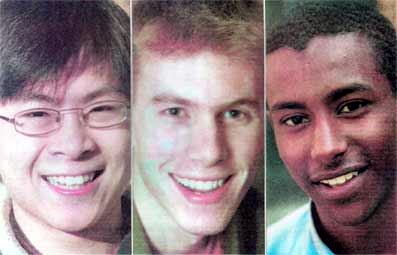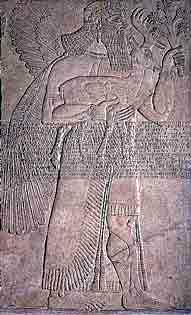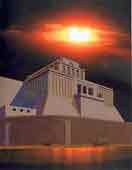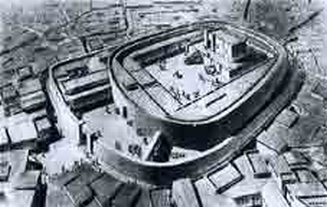The rapid development of mans 'tool kit' over the last 60,000 years, after millions of years of negligible progress requires explanation. The fact that the 'arrival' and progress of sapiens sapiens as a distinct species, coincided with this technical and creative explosion, has concentrated the minds of those using today's sophisticated 'detection aids' on the real reasons for, and explanations of our current existence.

Three boys
share a common ancestor of about 50,000 years ago Genetics & Genealogy
Science, archaeology and painstaking research have traced well developed agriculture, land tenure, accounting, good behaviour and common law to a technically advanced group, known to the Sumerians as the Anannage and to the early people of the Middle East as the Elohim (Shining countenanced, Lords of the Cultivation), who settled to farm a fertile basin in the mountains of Southern Lebanon around 9,300 BC. They have been attributed with the building of the seven major cities of the Levant: Kharsag (Eden), Jericho (8000 BC), Ba'albek, Ebla, Catal Huyuk, Olympus and On, and the later development of the Sumerian and other City States, which began around 6000 BC, some three thousand years before our current detailed knowledge of Egyptian history. Evidence is now 'reemerging' of their former island home.

Tablet depicting Kharsag Epic No3 The Romance of Enhil and Ninlil
Scholars of the pictorial Sumerian script (3500 BC), around the turn of the century, found so much similarity between the Sumerian and Chinese writing that they conjectured the two races to be kindred tribes, who once lived together in the highlands of Central Asia. However genetic analysis, translations of the earliest writing, cross referenced with later documents, oral traditions and the additional bio-archaeological evidence, show that the Elohim played the major role in developing the Sumerian, Chinese, Egyptian, Indus, Peruvian, Mexican and other cultures throughout the world and that their influence survives with us today. We still use thirty two Sumerian words in the English languages and now find that their precise surveying methods, triangulation and their standard unit of measurement were in use all over the world before 700 AD.

The Lady Ninkarsag in the guise of the Goddess of Irrigation 18th Century BC from Mari, Middle Euphrates, Aleppo Museum.
'Mama' - Progenitor of Modern Man - Earth Mother Goddess
Whilst early teaching remained practical, a clear thread runs from 8,750 BC throughout the world, of what can best be described as the Unity of Truth, forming the basis for all subsequent common law, philosophy and religion, a theme however, that has been corrupted over time. When King Hammurabi became ruler of Mesopotamia in 1792 BC, he made a declaration of existing law, by assembling Anu and Enlil's Elohim decrees, comprising of some 282 articles and had them 'cast on a stele' (stone pillar) erected in all the important public places, and as such, provided the 'common law', one of the major continuities of Mesopotamian civilization. This was the origin of The Hammurabi Code. "Let the oppressed man who has a cause - Come into the presence of my statue - And read carefully my inscribed stele". Sumerian law gave 'equal' rights to women and 'false accusers' were regarded and punished in a similar manner to thieves and murderers.
These early city state societies and their advanced cultural, technical and genetic progress were a legacy of the Elohim. Thus over time, many standards, including our genetic make up, have declined and are still in decline. The truth has been taken from us by priests, politicians and man's fickle nature. Scholars have taken the path of establishing concepts as truths, that should never have been placed in the receptive minds of uncritical men. The forces of evil have gained the upper hand over the forces of good, with the worship of 'sacred untruths' rather than the truth. Around 1500 BC Elohim war lords Ashur and Yahweh had played dominant and opposite roles in the 'shaping' of the subsequent single god culture following devastation of the great Bronze Age cultures by 'predicted' cyclical meteorite debris/fireball flux impacts around 2,350 BC.

Sculptured relief of one of the Elohim, 'caring for wildlife'. The palace of Sargon II at Khorsabad, Ninevah (720) BC). British Museum, Assyrian Room.
The Assyrian King Ashburnapal (668-625 BC), despite a bad press, had a taste for learning and antiquities. His finest relic is what survives of the great collection of tablets 'made' for the library in the fabulous palace, accredited to Sargon II (721-705 BC) at Khorsabad, near Ninevah. From these tablets, those from the Nippur library (2,800 BC) and the quality of earlier pictorial text, the truth will emerge. Amongst the greatest relics of this Assyrian cultural legacy, are however, the sculpted reliefs of the Elohim (ab-kar-llu) caring for wildlife and farming, from the prominent private palace room, which can now be seen in all their glory on display in the British Museum.

A temple of the Late Prehistoric period, c 3000 BC, at Eridu, modern Abu Sharhrain, in southern Mesopotamia. The main structure, built of mud brick, stood on a stone-faced platform. This architectural combination developed, into the ziggurat or temple tower characteristic of later Mesopotamian cities.
The Chinese way of thought the 'The Tao' has been attributed to the 'Yellow' Emperor, Huang Ti, who lived from 2698 to 2597 BC, but bio-archaeological evidence suggests the early Elohim presence and the source for this philosophy emanating through their intensive farming (inc. Kharsag millet) in the Huanghe and Yangzie river basins before 6,500 BC. The best known Chinese philosophers were Lao-Tse and Confucius, whose teachings around 520 BC were based on 'The Tao' philosophy. The relative stability in the cultural development of China over 7000 years, provides many clues and unique links to the Elohim. 'The Tao' is still a pillar of Chinese society. (Words of Meng-Tzu): "Every man possesses in himself the four principles of benevolence, justice, propriety and wisdom, and that man has only to obey the law within himself in order to be perfect". Plato emphasised soon afterwards that good people do not need laws and bad people break them away. (Words from I Ching - Book of Changes): "The superior man, who sees not only things but the tao of things, is rare. The tao of the universe is indeed kindness and wisdom; but essentially tao is also beyond kindness and wisdom".
Such practical advice was also given by Jesus of Nazareth. However recent translations of the Askew and Bruce Codicies written in the early Coptic texts at the time, reliably illustrate the additional dominant spiritual nature of the teaching of Jesus of Nazareth imparted to his inner circle of disciples. This provides additional support for the common links beyond the teachings of Leo-Tse and Confucius to the other prominent 'living masters', Osiris to the Egyptians, Zoroaster the Prophet of the Persians, Gotama the Buddha and Mohammed the Prophet of Allah, all reinforcing the concept of the Unity of Truth and the single Elohim origin. Historical facts passed down from the Elohim, Sumerian, Babylonian, Hebraic, Hindu and Moslem successions over 7,000 years have lost key elements of content, confusing religious historians. Other evidence supports the yet unexplained 'spiritual' dimension, maybe influenced by a not yet understood DNA energy source.
Tzu-king asked if the Master (Confucius), could give him one word to serve as a rule of life. The Master said:
"Would not 'reciprocity' be such a word? What you do not wish others to do unto you, do not unto them".
Jesus preached in these term: "Do unto others as you would wish them to do unto you".
All religions have two common directives:
1. Strive for spiritual as well as material development.
2. Live in harmony with the world; in harmony with yourself; in harmony with your fellow creatures; and in harmony with all the forces of nature up to the supreme, itself or himself.

Supernatural being or farmer pollinating his plants?
In AD 312 the Emperor Constantine, who continued to regard the Caananite-Phoenician sun-god Baal (Anu) as the supreme being, decreed Christianity the official religion of the Roman Empire and two years later in AD 314, four British Bishops attended the Church Council at Arles. However prior to Christianity, throughout the world, even in the temple of Mithras beneath St Peter's in Rome, the Elohim were worshiped as gods. It took the burning of the great libraries in Alexandria, Cordoba and Carthage, and the destruction of as much of the earlier evidence and historical record as possible to gradually establish the 'Christian' principles and the ultimate domination of so called 'pagan (country folk) practices' by Rome, and the other new single god 'religious' centres, which grew from the major climatic, economic and social, cyclical low points in history.
St Patrick (AD 387-461) believed to have been born near Caerwent in Wales, served four years practical farming as a slave at Saul in Ireland subsequently returning as a Catholic Bishop in AD 432. He instigated the burning of the Irish Druidic books, which were written in the ancient Phoenician alphabetic text, and he became famous for banishing the snakes (the Druidic Serpent Knowledge) from Ireland. Theses actions highlighting the conflict between the changes in Rome at this time on issues such as original sin, and the long held Celtic traditions of druidic philosophy, which promoted above all the freewill of man, the pursuit of knowledge and a priesthood of peace. Both Britain and Ireland had to contend with cyclical meteorite debris impacts c. 540, which brought severe climatic depression on a global scale. This and other natural disasters later prompted the 'Norse' migration invasions and horrific destructions, leaving some Irish in Ireland for ever fighting their shadows and forgetting their glorious past, genetic identity and the historical realities of the Land of Eternal Youth, the temporary home of the 'immortals'. However the Celtic Church in these difficult times managed to export the less corrupted Celtic and Greek truths and traditions, lifting hearts and confidence high, as did the Cathars 800 years later in Languedoc.
The Elohim, Phoenician traders and Celtic Greek mercenaries had brought from the Fertile Crescent, their traditions of learning to Ireland, long before the occupation of the British mainland by the Romans. St Patrick was unable to overturn the ancient Celtic traditions and the Irish developed the very special Celtic 'monastic university' culture, based on the Greek language and the well established or imported sciences of that time. This led from Bangor and other centres of learning, the export of Irish practical, agricultural, engineering, intellectual and 'religious' dominance over Scotland, Wales, England, France, Germany and Northern Italy, initially by no more than 300 wandering extrovert monks ("no visible goods, knowledge for sale"). Their influence spread in difficult times as far east as Kiev, exemplifying the power of good over evil. Rome had fallen to the Arian Christians led by Aleric in AD 408. Sadly the Arian Christians were finally labelled and banished as heretics by the Church of Rome to the determent of the future of the whole Mediterranean region. Starvation, disease and forced migration's, adding to the pressures on the Roman Empire. Many Belgae/Celtic tribal groups in the west of Britain moved south to northern France, their descendants returning with William in AD 1066.

A reconstruction by Hamilton C. Darby of a Mesopotamian temple (Khafajah) from the early half of the third millennium BC excavated by the Iraq expedition of the Oriental Institute of the University of Chicago.
St Columbanus (AD 543-615), was the most outstanding of the Irish 'farmer' monks (biographer Marguerite M. Dubois), who founded many high quality 'monastic universities', including those at Annegray, Fontaines, Luxeuil and his last and most famous at Bobbio, the centre of learning in Northern Italy. Author of the Monastic Rule and Penitential, he writes in AD 614: "Was there not of old, a philosopher, wiser than all the others, who was thrown into prison for holding against the opinion of all, that there was only one god?"
The third dominant figure was mathematical St Feargal (d. AD 784). He became Bishop of Salzburg, much to the disapproval of rival Benedictine St Boniface from Devon. Feargal believed and taught that the earth was round, and not only round, but that it had north and south poles! Feargal with a brilliant mind and sense of humour was perhaps one of the last to survive such a "perverse and wicked personal doctrine", which was in opposition to God and Catholicism. He dealt with this problem, by taking on St Boniface and Pope Zacharias in good humoured scientific disputations. After all Feargal came from a land where 'pagan' predecessors of the Celts were using Anu and Enli's Elohim encyclopedia of astrology and complex algebra, to plot the paths of the sun, moon, stars and cometry debris. They knew of the 25,000 year precession cycle of the stars and full descriptions of 12 planets (the 12th now being confirmed). The tradition of 'the wanderers' practical search for the truth, lived on in the monastic universities of Europe to emerge 733 years later in 1517 with Augustine monk Martin Luther.
Eleven hundred years after Feargal, the first missionaries, contacting the remote Effe pygmies in Zaire, were astonished to find them praying to "Our Father in Heaven" and reciting the Adam and Eve story, with its prohibition on eating fruit from the tahu tree. It is not difficult to see how their monotheistic religion, fund of mythic stories, commanding oral tradition like their other isolated groups, could have traveled down the Nile from their Egyptian "ancestor goddess" Bes, surviving thousands of years, providing their own direct link to the common creation story, stemming from the original Elohim settlement. Detailed studies of all primitive oral history from Aborigine, Aka, Aztec, Berber, Carib, Dogon, Eskimo, Khwe, Masai and Zulu, tell the same story and provides additional evidence of contact with and activities of the Elohim.
All great 'civilizations' (more than seven) were born out of agricultural competence, favourable natural conditions and subsequent abundant food supplies. (Britain with a large population, exported metals, grain, wool, cattle and hides early in the Roman occupation). The inevitable cyclical demise of such highly developed complex societies, has had much to do with ignorance, contempt and neglect of rural practices, potential and heritage. Arising when the vast majority of the population became urbanised and too far devolved from both rural practicality, common sense and an affordable quality variety diet. History tells us that civilization, is a description that disintegrates into civil-corruption and dogma. Plato warned that growing financial demands within democracies always lead to debt, bankruptcy and chaos.
The rural simplicity of the 'hunter-gatherer-fisher-horticulturalist-herder', who 'belonged' to the land, has provided the enviable continuity and quality of life to so called 'primitive' peoples, such as the world's Pigmies, South and North American Indians, Indonesian Head Hunters and Cannibals, until that is, they were wiped out by the so called 'civilized peoples'. These peoples practiced respect for man and nature, the custodians and managers of the world's sustainable resources. North American Indians had inherited or developed, well before the arrival of Europeans extremely sophisticated and efficient farming and wildlife management techniques, which were soon lost and have never been improved upon. Chief Sitting Bull on a visit to the poverty of the American East Coast in the 1870's, before he was shot in the back said: "White man can make everything, but cannot distribute it." Malnutrition and starvation now dominate most societies. Around 160 million people have been killed in the last 100 years through failed political attempts to establish equality. The solutions available from past knowledge require renewed application. Henry George in Protection or Free Trade 1896: "Here is the conclusion to the whole matter":
"That we should do unto others as we would have them do unto us - that we should respect the rights of others as scrupulously as we would have our own rights respected is not a mere counsel of perfection to individuals, but is the law to which we must conform social institutions and national policy if we would secure the blessings of abundance and peace."